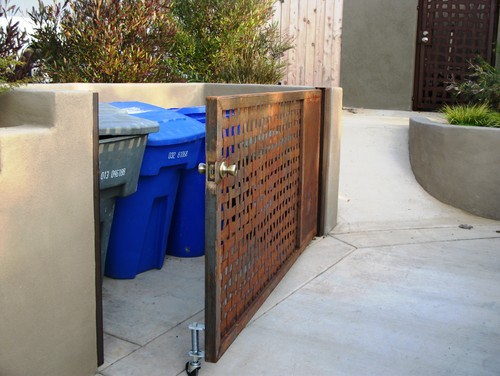Do you know? Between 1960 and 1990, trash production has doubled, and despite a growing push to recycle and reuse, landfills are expanding every day. Households in North America are creating and throwing away more waste than ever. From junk mail to excess paint to food scraps, this garbage takes time and money to deal with.

Photo by debora carl landscape design – More landscaping ideas
It’s time to correct not the symptoms but the disease, and to do that, we should all, reduce.
Steps to take:
1. Reduce Excess Paper at Home.
A good portion of what you throw in the garbage each day is paper (almost 30% of American garbage). Much of the paper generated in our homes comes in the mail. The average American household receives more than 500 pieces of advertising mail each year.
Solution:
– Receive and process bank statements, pay stubs, bills, and many other documents entirely electronically.
– If you just want to stop certain catalogs, you can contact individual mailers and ask them to remove your name from their mailing lists; call them or send your request by mail or e-mail. Read newspapers and magazines online if they are available there.
– Return egg and berry cartons to the vendors at the farmers’ market for reuse.
– Don’t print things if you can see them on screen.
– Recycling junk mail is okay, but reducing the flow of junk mail will conserve natural resources, save landfill space, and save you time and money. One call to 1-888-5-OPT-OUT will reach the major national credit bureaus, Equifax, Experian and Trans Union.
Luxury Modern Pools and Patios | How To Build A House (howtobuildahouseblog.com)
2. Reduce Packaging Waste.
Packaging makes up 30 percent of municipal solid waste. You can reduce the amount of packaging you throw in the garbage.
Solution:
Do not buy over-packaged products.
– Don’t buy things packaged in individual serving sizes. Buy one larger bottle instead of four or eight smaller ones.
– Buy one larger container instead of many smaller ones. However, over-packaged products often cost more than less-packaged products. This means that you can save money when buying products with less packaging.
– Take your own reusable cloth bag so you don’t need “paper or plastic.”
– No water in plastic bottles and no soda in cans.
– Ask for no bags if you only bought items that you can easily carry or if the items are going straight from cart to car to kitchen.
– Buy fresh, unpacked, fruits and vegetables; buy grains, pasta and dried fruit in bulk.
3. Prevent Food Waste and Compost Organics.
Food is wasted in many ways, such as preparing too much, letting fresh food go bad and buying too much.
Solution:
– Planning meals and creating a list of what you need before you go to the grocery store that will help you buy exactly what you need.
– Composting leftover fruit and vegetable food waste with your yard waste helps create high-nutrient compost. It will improve your soil and your garden without the use of chemical fertilizer.
– Donate excess canned goods to a food shelf.
4. Use the Least Hazardous Cleaning Products.
Read the labels of cleaners and look for the words: caution, warning, danger, poison, which indicate the level of hazard. Use the least hazardous product to do the job. Read the instructions on how to use cleaning products and be sure to use the correct amount.
5. Maintain and Repair Instead of Replacing.
Don’t throw out your vacuum cleaner if it isn’t picking up. Check the bag and the belt and make sure the hoses are free of clogs.
6. Buy for Durability.
Whenever possible, choose a product that you will use for a long time and be able to maintain and repair should it be necessary. It may cost a bit more up front, but it will save waste and money in the long run.
7. Give or Sell what You Don’t Need; Reuse & Recycle.


